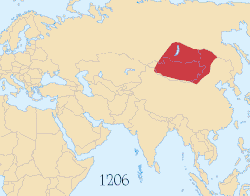မွန်ဂိုအင်ပါယာ
မွန်ဂိုအင်ပါယာသည် ၁၃ ရာစုမှ ၁၄ ရာစုနှစ်အတွင်း တည်ရှိခဲ့သည့် ကြီးမားကျယ်ပျံ့သော အင်ပါယာကြီး တစ်ခုဖြစ်သည်။ အာရှအလယ်ပိုင်းဒေသမှ အစပြုကာ ကိုရီးယားကျွန်းဆွယ်မှ အရှေ့ဥရောပအထိ ကျယ်ပျံ့ကာ မြောက်ဘက်တွင် ဆိုက်ဗေးရီးယား၊ တောင်ဘက်တွင် အရှေ့တောင်အာရှ၊ တောင်အာရှနှင့် အရှေ့အလယ်ပိုင်း ဒေသများ ပါဝင်သည်။ ကမ္ဘာ့သမိုင်းတွင် အကြီးမားဆုံး အင်ပါယာကြီးဖြစ်သည်။ အလျား မိုင် ၆၀၀၀ ခန့်ရှည်ပြီး ဧရိယာမှာ စတုန်ရန်းမိုင်ပေါင်း ၁၂.၇၄၁ သန်းခန့် ရှိသည်။ ကမ္ဘာ့မြေဧရိယာ၏ ၂၂ % ရှိပြီး လူဦးရေ သန်း ၁၀၀ ခန့် ရှိသည်။
| |||||||||||||||||
 Mongol Empire တည်နေရာ | |||||||||||||||||
| မြို့တော် | ခန်ဘာလီမြို့(ပေကျင်းမြို့) Avarga Karakorum (1220–1271) | ||||||||||||||||
| ကိုးကွယ်ယုံကြည်မှု | Tengriism (Shamanism)၊ ခေတ်နှောင်းပိုင်း ဗုဒ္ဓ၊ ခရစ်ယာန်၊ အစ္စလာမ် | ||||||||||||||||
| အစိုးရစနစ် | ရွေးကောက်တင်မြှောက်သည့် ဘုရင်စနစ် | ||||||||||||||||
| မဟာခန် | |||||||||||||||||
| - 1206-1227 | ဂျင်ဂစ်ခန် | ||||||||||||||||
| - 1229-1241 | Ögedei Khan | ||||||||||||||||
| - 1246-1248 | Güyük Khan | ||||||||||||||||
| - 1251-1259 | Möngke Khan | ||||||||||||||||
| - 1260-1294 | ကူဗလိုင်ခန် | ||||||||||||||||
| - 1333–1370 | Toghan Temur | ||||||||||||||||
| 立法机关 | Kurultai | ||||||||||||||||
| သမိုင်း | |||||||||||||||||
| - ဂျင်ဂစ်ခန် မျိုးနွယ်စုများအား စည်းလုံး | 1206 | ||||||||||||||||
| - ဂျင်ဂစ်ခန် ကွယ်လွန် | 1227 | ||||||||||||||||
| - Pax Mongolica | 1210-1350 | ||||||||||||||||
| - Fragmentation of the empire | 1260-1264 | ||||||||||||||||
| ငွေကြေး | ဒင်္ဂါး၊ စုခ်ဟဲ၊ ငွေစက္ကူ | ||||||||||||||||
| |||||||||||||||||
မွန်ဂိုခေါင်းဆောင် ဂျင်ဂစ်ခန်၏ ဦးဆောင်မှုအောက်တွင် မွန်ဂိုလူမျိုးများနှင့် တာခစ်လူမျိုးများသည် ယနေ့ မွန်ဂိုလီးယားဒေသတွင် စုပေါင်းစည်းလုံးလာပြီး ၁၂၀၆ ခုနှစ်တွင် မွန်ဂိုအင်ပါယာအဖြစ် စတင်ပေါ်ထွန်းလာသည်။ ဂျင်ဂစ်ခန်နှင့် နောက်မျိုးဆက်များသည် မွန်ဂိုတပ်သားများကို အရပ်ရပ်သို့ စေလွှတ်တိုက်ခိုက်ကာ နယ်မြေများကို သိမ်းပိုက်ခြင်းကြောင့် မွန်ဂိုအင်ပါယာကြီး အရှိန်အဟုန်နှင့် ကြီးထွားလာသည်။[1][2][3][4][5][6][7][8][9] မွန်ဂိုလက်ထက်တွင် ဥရောပနှင့် အာရှတစ်လွှား နည်းပညာအသစ်များ၊ ကုန်စည်များနှင့် သဘောတရားအသစ်များကို ဖြန့်ဖြူးဖလှယ်လာကြသည်။
၁၂၆၀ ခုနှစ်တွင် ကူဗလိုင်နှင့် အရိဘိုကဲ ညီအစ်ကိုနှစ်ဦး ထီးနန်းဆက်ခံနိုင်ရေးအတွက် အားပြိုင်ကြရာ သွေးကွဲမှုများ ရှိလာသည်။[10] ကူဗလိုင်က အောင်မြင်စွာ နန်းတက်နိုင်ခဲ့ပြီး ယွမ်မင်းဆက် စတင်ခဲ့သည်။ သို့သော်လည်း သွေးကွဲမှုက အဆုံးမသတ်ခဲ့ပေ။ ကူဗလိုင်ခန်ကွယ်လွန်ပြီးနောက် မွန်ဂိုအင်ပါယာကြီးမှ နယ်မြေ ၄ ခုခွဲထွက်သွားသည်။ [11] ၁၃၆၈ ခုနှစ်တွင် ဟန့်တရုတ်လူမျိုး ကျူးယွမ်ကျန်းက ယွမ်မင်းဆက်ကို တွန်းလှန်ကာ မင်မင်းဆက်ကို ထူထောင်လိုက်ချိန်တွင် မွန်ဂိုအင်ပါယာကြီးလည်း ပြိုကွဲသွားရသည်။
ကိုးကား
- Jared Diamond - Guns, Germs, and Steel, p.367
- Historical Dictionary of the Mongol World Empire, by Paul D. Buell
- The Mongols and Russia, by George Vernadsky
- The Delhi Sultanate: A political and military history, by Peter M. Jackson,
- The Mongol World Empire, 1206-1370, by John Andrew Boyle
- The History of China, by David Curtis Wright, p. 84
- The Early Civilization of China, by Yong Yap Cotterell, Arthur Cotterell, p. 223
- Genghis Khan and the making of the modern world by Jack Weatherford
- Mongols and Mamluks: The Mamluk-Ilkhanid War, 1260-1281 by Reuven Amitai-Preiss
- Michael Biran, Qaidu and the Rise of the Independent Mongol State in Central Asia. The Curzon Press, 1997, ISBN 0-7007-0631-3
- The Cambridge History of China: Alien Regimes and Border States, p413